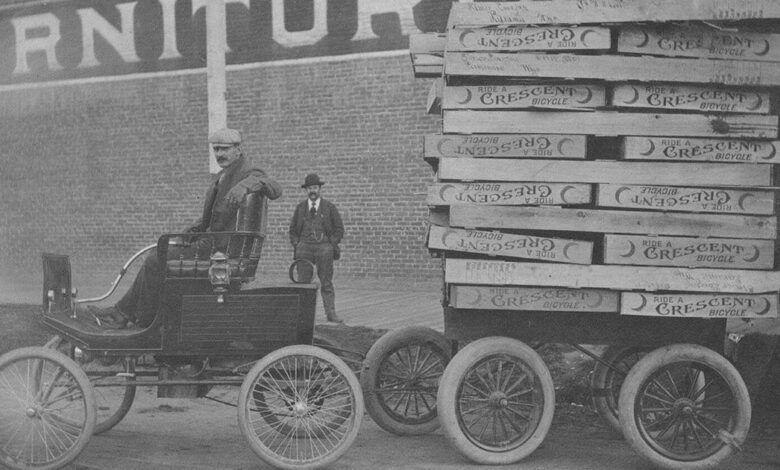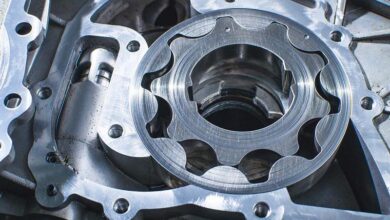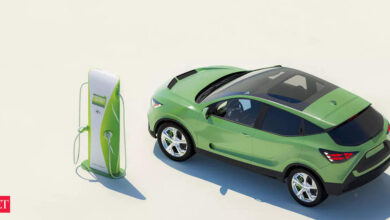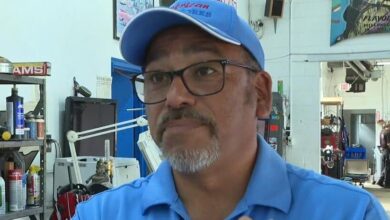Laramie Inventor Elmer Lovejoy Built And Drove Wyoming’s First Car

Elmer Floyd Lovejoy took a little drive in downtown Laramie on May 7. He waved to a few acquaintances as he puttered down Second Street at an unthinkable 8 miles per hour.
“Strange, isn’t that the bicycle repair guy?” thought a bystander or two.
“I think so. And where is he off to in such a hurry?”
The 26-year-old was well known in town. He and the adorable Nellie Oakley were married three years prior. Nellie was pregnant with the couple’s first child, a son. They would name him Orell.
Lovejoy’s joyride was a noteworthy one. No one in Laramie, or Wyoming for that matter, had yet seen an automobile. It was 1898. Folks had read about horseless carriages, likely scoffed at the notion and gave it little further thought.
After all, the Spanish-American War was on. That dominated headlines. Plus, horses outnumbered people in Wyoming. Saddlemakers weren’t exactly sweating Lovejoy’s toy.
A First Of Sorts
Lovejoy’s test outing of his motorized carriage in 1898 was historically significant for the state. The event itself was the first known appearance of an automobile in Wyoming, and some say among the first west of the Mississippi.
It was Lovejoy’s passion for biking combined with his obsessive tinkering that eventually led the burgeoning inventor to come up with plans for his horseless buggy in 1985. Three years later he was making his historic test drive in Laramie.
Lovejoy’s “car” was not the first. Inventors in France, Germany and the United States had already filed patents decades earlier. A steam-powered auto had existed a century prior to that. What Lovejoy did, though, is invent a version of the steering wheel still in use today. But he technically wasn’t the first to do that either.
Lovejoy also was one of the early mechanic-minded inventors to recognize automobiles would need pneumatic tires, not just solid rubber. With all that accomplished, Lovejoy eventually set his sights on designing an automatic garage door opener, and he may have had an instrumental role in America’s first road map.
Growing Up With Elmer
Lovejoy was born in Illinois on Feb. 2, 1872. His family moved to Laramie in 1883 in search of a drier climate for Elmer, who was diagnosed with consumption (tuberculosis). Lovejoy graduated from Laramie High School and went off to college at University of Wyoming.
Books weren’t for him, though, and Lovejoy dropped out after three short months to become an apprentice at the Cook & Callahan planing mill. He picked up things fast. In no time, Lovejoy was assigned to major construction projects like the Edward and Jane Ivinson mansion (now the Laramie Plains Museum) and St. Matthew’s Episcopal Cathedral.
When the mill went bankrupt, Lovejoy caught on with a ranching outfit in North Park, Colorado, for $30 a month. Once the foreman found out how good the tinkerer was at fixing things, he never rode a horse again.
But he did ride a bicycle — all the way to Chicago. With his ranch earnings, Lovejoy bought his first bike and set out for Chicago with his heart set on seeing the World’s Fair in 1893. He averaged 80 miles a day. It took him two weeks.
Turns out he didn’t need to hurry. The fair’s opening was delayed by weather and other issues until May of the following year. But on the way, the 20-year-old cyclist managed to meet his future wife — a 15-year-old Woodbine, Iowa, saddlemaker’s daughter named Nellie Oakley.
Once back in Laramie, Lovejoy took a job as a mail carrier. He also repaired bicycles on the side. After a year toting letters, Lovejoy opened his own shop, Lovejoy Novelty Works, on the second story of the post office at 315 S. Second St. The shop would move several times, eventually settling at its best-known location — 412-414 S. Second St. in a building that still stands.
Lovejoy continued a correspondence and courtship with Nellie. The two were married Aug. 27, 1895. Within four years, the entire Oakley family relocated to Laramie with some eventually coming to work for Elmer.
Fix-It Guy Builds A Car
Elmer’s reputation for being able to fix just about anything began spreading throughout Laramie and beyond. When he wasn’t repairing a flat tire on a bicycle or getting someone’s Edison phonograph back in working order, Lovejoy was working on designs for an automobile.
Lovejoy borrowed heavily from what he knew — bicycles. Just like fellow Illinois bicycle mechanics J. Frank and Charles Duryea, who would go on to design and build the first American gas-combustion automobile in 1893, it was creative bicycle-makers in the U.S. that spearheaded efforts toward turning two-wheeled pedal bikes into four-wheeled autos.
He may not have been able to behold the world’s wonders at the Chicago Fair, but if that 2,000-mile roundtrip bike adventure taught Lovejoy anything, he was driven to invent a locomotive source that did not include equine nor human power.
The winter of 1897-98, Lovejoy worked tirelessly on his invention. He told the Laramie Boomerang he expected to have his “horseless carriage ready for operation by May 1.” He was just waiting on delivery of the one-cylinder, two-cycle marine engine.
Lovejoy’s car was driven by two chains connected to both rear wheels. The conveyance ran on 1 ¾-inch solid rubber tires mounted on the iron wheels. It had a T-bar tiller as the steering mechanism. The 940-pound carriage had two seats, able to comfortably carry four passengers.
Lovejoy test drove the model Saturday night and Sunday, May 7 and 8, 1898, to an audience of oohing and aahing townspeople.
“There were two speeds in use on the machine yesterday, one of five and one of ten miles per hour. When the machine was on good hard places it acquired a speed of ten or twelve miles per hour,” the Boomerang recapped.
Lovejoy said he could have hit 15 if he didn’t second-guess his original idea of running balloon tires. He mistakenly thought a pneumatic tire would not be practical for the heavier machine considering the pounding it would be subjected to by road conditions. None of Laramie’s streets were paved.
Lovejoy had Morgan and Wright Bicycle Tire Co. of Chicago build him extra heavy duty 4-inch-wide air-filled tires for which there “wasn’t a spare in the world,” Lovejoy told the Boomerang at the time.
The wider pneumatic tires would better absorb bumps and keep the rig from digging itself into ruts. It would not be until he 1920s that air-filled tires became the standard on commercial automobiles. Once again, Lovejoy was ahead of his time.
Steering Wheel Invention
Another lesson Lovejoy quickly learned was steering his contraption had to get better. The T-bar tiller was cumbersome and tiring. It was problematic to get the two front wheels to pivot in unison on the same axle under the weight of the vehicle body out over them.
Automakers in France, where the car was born, were having the same problem. Then, almost all at once, three different designers hit upon the idea of a steering wheel.
Alfred Vacheron modified a Panhard and Lavassor model for a Paris-Rouen race in 1894 using a steering wheel instead of a tiller. Arthur Krebs improved the design in 1898 to make it tilt at an angle facing the driver.
In Britain, Charles Stewart Rolls bought a Panhard from France and implemented his own steering steering wheel idea into his designs.
Meanwhile, in the U.S., Ohio bicycle manufacturer Alexander Winton is credited with creating the first mass-market steering wheel-equipped car in 1898.
In the late 1880s, Michigan bicycle manufacturer Sterling Elliott was also perfecting his steering knuckle mechanism that made use of tie-rods — essentially the same assembly still used in today’s cars. He was paid royalties by numerous U.S. car manufacturers until his patent expired in 1907.
Lovejoy went back to the drawing room to invent a better steering mechanism. He came up with his own steering knuckle design in 1905. His father refused to fund his effort to apply for a patent, so he sold the rights to Locomobile Company for $800 and one of their Locomobile Steamer automobiles. He received Locomobile #55, the 55th car commercially manufactured in the United States.
Meanwhile, the automotive industry moved on at a blistering pace.
Inventor-Turned-Businessman
By 1902, the first gasoline-powered car was brought to Laramie that January. It was an Oldsmobile bought by Dr. H. L. Stevens. Lovejoy assembled it for him when it came off the train, undoubtedly enjoying the chance to reverse engineer such a machine.
Around that time, local rancher W. B. Emmons also brought a gasoline car to Wyoming — Laramie’s first Franklin. Lovejoy was so enamored with the air-cooled engine able to run at high-altitude that he signed on to be one of Franklin Motor Car Co.’s first authorized dealers in 1904.
Early on in the relationship, Franklin sent a sales manager from its home office in Syracuse, New York, to Wyoming to see why Lovejoy’s sales numbers were not very encouraging. Maybe he just needed a few marketing tips.
The Franklin man arrived by train and was soon touring about the countryside with Lovejoy pointing out his territory. After traveling several miles outside of town, Lovejoy pointed out a ranch whose owner had bought a Franklin. Hours later, they passed a second ranch, and by the end of the day they had seen only half a dozen places where there was any sign of life.
Laramie population at the time was about 8,207, and Albany County was only 13,084.
After that the Franklin rep apologized, stating he didn’t know how Lovejoy managed to sell the number of cars he did.
Lovejoy also sold Studebakers for a while and opened Laramie’s first car rental business in 1907.
The Laramie Republican in 1905 proclaimed, “Among the most prominent and indispensable businessmen of the city is Elmer Lovejoy … who has a reputation all around Laramie for ‘mending any old thing.’”
The Republican went on to call Lovejoy a “genius with tools,” noting his commitment to public service as well. Lovejoy was a Laramie City Council member, active with the fire department and a member of various town committees. He also belonged to the Benevolent Protective Order of Elks and was a member of the Laramie Chamber of Commerce.
Lovejoy Maps His Future
But the Laramie businessman wasn’t done yet.
Gov. Bryant Brooks took note of Lovejoy’s popularity and chose him to attend the Good Roads Convention in Buffalo, New York, as efforts were underway to plan and plot the Lincoln Highway. The transcontinental road connecting the Atlantic and Pacific oceans crossed 13 states.
Lovejoy was the perfect person to help guide it through his city and the surrounding Laramie Valley, at one point stretching east in the Sherman Mountains at the highway’s highest point at 8,835 feet elevation.
After all, it was Lovejoy who helped found the Laramie Bicycle Club in 1902. He was one of cycling’s biggest proponents. He even built a bicycle for two for he and his wife to ride.
In addition, Lovejoy’s shop was the undisputed center for all mechanical and transportation needs. He also became a Crescent brand bicycle dealer when the Swedish maker with roots in Chicago began U.S. sales in 1908.
When the highway opened in 1912, Lovejoy assisted the National Highways Association with making one of America’s first road maps, pointing out places of interest in Wyoming and the Laramie area.
Lovejoy’s final contribution to the world came in 1917 when he invented an automatic garage door opener. He filed U.S. patents in 1918 and 1921. For some time, he was the sole manufacturer and distributer for the doors anywhere in the country.
Just before retiring and moving to Santa Ana, California, an 80-year-old Lovejoy sat down with Laramie Boomerang reporter Vandi Moore for an interview in December 1952.
Lovejoy told Moore he had never gotten in an automobile accident in his life, which included more time behind the wheel than any of his contemporaries, an estimated 1 million miles.
“I believe I’ve driven longer than any other driver in the world,” said Lovejoy, who was then driving a Chevrolet.
Lovejoy admitted his retirement in California would probably include a little tinkering, but his time in the automotive industry was long over. He said he had convinced himself he could make a car and satisfied the curiosity of many others. He was content with that.
Lovejoy died in California in 1960. His legacy lives on in a popular downtown Laramie hangout, Elmer Lovejoy’s Bar and Grill, named in his honor. It’s a one-minute bike ride from his old shop.
Jake Nichols can be reached at jake@cowboystatedaily.com.



